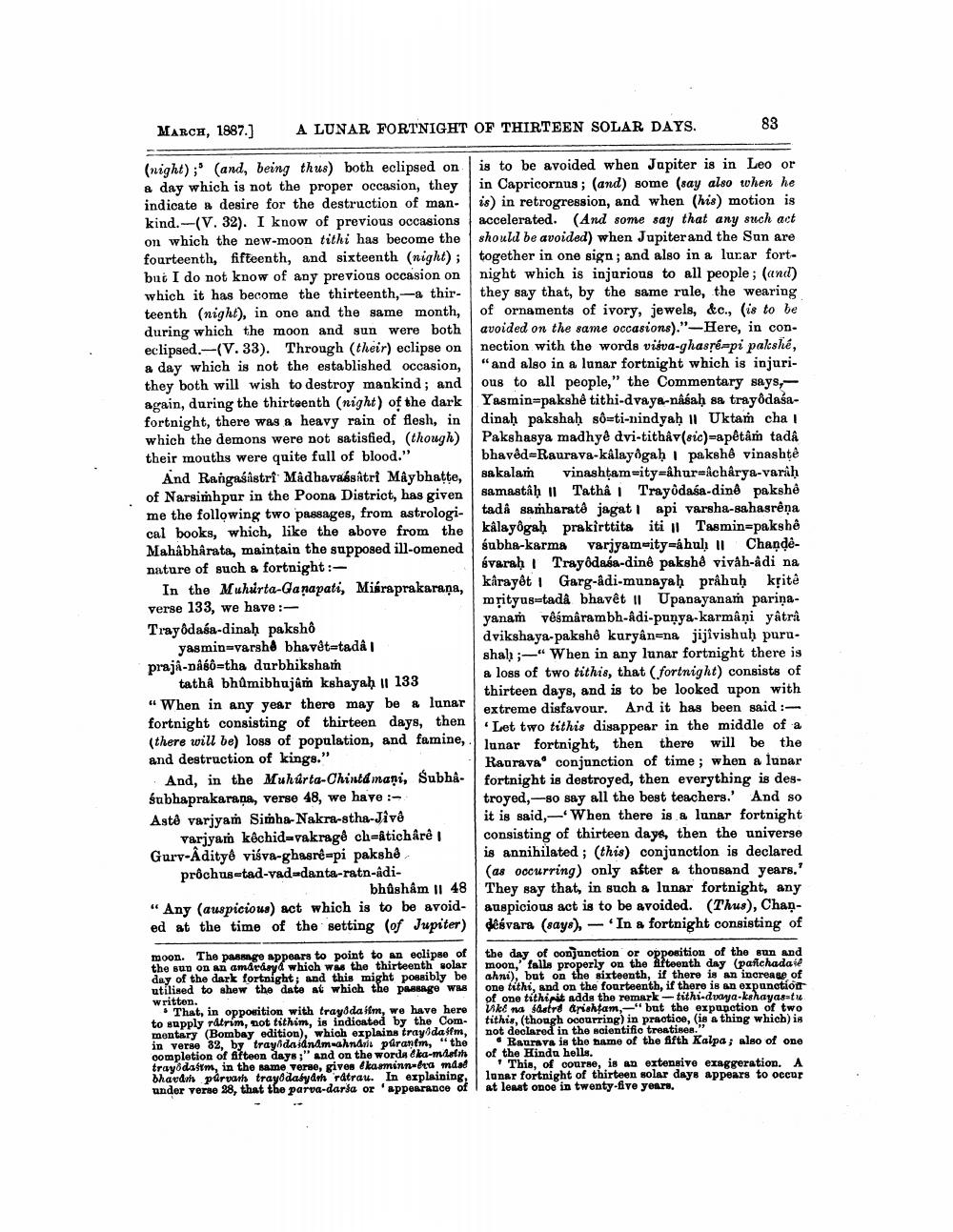________________
MARCH, 1887.] A LUNAR FORTNIGHT OF THIRTEEN SOLAR DAYS.
(night); (and, being thus) both eclipsed on a day which is not the proper occasion, they indicate a desire for the destruction of mankind. (V. 32). I know of previous occasions on which the new-moon tithi has become the fourteenth, fifteenth, and sixteenth (night); but I do not know of any previous occasion on which it has become the thirteenth, a thirteenth (night), in one and the same month, during which the moon and sun were both eclipsed. (V. 33). Through (their) eclipse on a day which is not the established occasion, they both will wish to destroy mankind; and again, during the thirteenth (night) of the dark fortnight, there was a heavy rain of flesh, in which the demons were not satisfied, (though) their mouths were quite full of blood."
And Rangasastri Madhavassâtri Mâybhatte, of Narsimhpur in the Poona District, has given me the following two passages, from astrological books, which, like the above from the Mahabharata, maintain the supposed ill-omened nature of such a fortnight:
is to be avoided when Jupiter is in Leo or in Capricornus; (and) some (say also when he is) in retrogression, and when (his) motion is accelerated. (And some say that any such act should be avoided) when Jupiter and the Sun are together in one sign; and also in a lurar fortnight which is injurious to all people; (and) they say that, by the same rule, the wearing of ornaments of ivory, jewels, &c., (is to be avoided on the same occasions)."-Here, in connection with the words visva-ghasṛré-pi pakshé, "and also in a lunar fortnight which is injurious to all people," the Commentary says,Yasmin-pakshê tithi-dvaya-nâśaḥ sa trayôdasadinaḥ pakshaḥ sô-ti-nindyah 1 Uktam cha Pakshasya madhyê dvi-tithâv(sic)=apêtâm tadâ bhavêd-Raurava-kalayogaḥ pakshê vinashtê sakalam vinashtam-ity=âhur=âchârya-varah samastâḥ | Tathâ| Trayodasa-dinê pakshe tada samharatê jagat api varsha-sahasrêņa kalayogaḥ prakirttita iti | Tasmin-pakshê subha-karma varjyam-ity-ahul II Chandêévarah Trayôdasa-dinê pakshê vivâh-âdi na kiraye Garg-di-munayah prihah krité mrityus-tadâ bhavêt Upanayanam pariņayanam vêśmarambh-âdi-punya-karmâņi yâtrâ dvikshaya-pakshê kuryân-na jijîvishuḥ purushal;"When in any lunar fortnight there is a loss of two tithis, that (fortnight) consists of thirteen days, and is to be looked upon with extreme disfavour. And it has been said :'Let two tithis disappear in the middle of a lunar fortnight, then there will be the Raurava conjunction of time; when a lunar fortnight is destroyed, then everything is destroyed, so say all the best teachers.' And so it is said, 'When there is a lunar fortnight consisting of thirteen days, then the universe is annihilated; (this) conjunction is declared (as occurring) only after a thousand years." They say that, in such a lunar fortnight, any auspicious act is to be avoided. (Thus), Chandêsvara (says),In a fortnight consisting of
In the Muhurta-Gapapati, Miraprakaraga,
verse 133, we have:
Trayôdasa-dinah pakshô
yasmin-varsh bhavêt-tadâ praja-nâsô-tha durbhiksham
tatha bhûmibhujâm kshayah 11 133 "When in any year there may be a lunar fortnight consisting of thirteen days, then (there will be) loss of population, and famine, and destruction of kings."
And, in the Muhurta-Chintamani, Subhâsubhaprakaraṇa, verse 48, we have :Aste varjyam Simha-Nakra-stha-Jivê
varjyam kêchid-vakragê ch-âtichârê Garv-Adity viva-ghaaré-pi pakabė
prochus tad-vad-danta-ratn-âdi
bhûshâm II 48 "Any (auspicious) act which is to be avoided at the time of the setting (of Jupiter)
moon. The passage appears to point to an eclipse of the sun on an amávásy which was the thirteenth solar day of the dark fortnight; and this might possibly be utilised to shew the date at which the passage was written.
83
That, in opposition with trayodaifm, we have here to supply råtrim, not tithim, is indicated by the Commentary (Bombay edition), which explains trayodaifm, in verse 32, by traydasanamahndi püranfm, "the completion of fifteen days;" and on the worda ka-mastm trayodastm, in the same verse, gives kasminn-era másé bhavam parvam trayodayam ratrau. In explaining, under verse 28, that the parva-darśa or appearance of
"
the day of conjunction or opposition of the sun and moon, falls properly on the fifteenth day (pañchadail ahni), but on the sixteenth, if there is an increase of one tithi, and on the fourteenth, if there is an expunction of one tithipit adds the remark-tithi-dvaya-kshayas-tu. Vike na sastre arishtam," but the expunction of two tithis, (though occurring) in practice, (is a thing which) is not declared in the scientific treatises."
Raurava is the name of the fifth Kalpa; also of one of the Hindu hells.
This, of course, is an extensive exaggeration. A lunar fortnight of thirteen solar days appears to occur at least once in twenty-five years.




